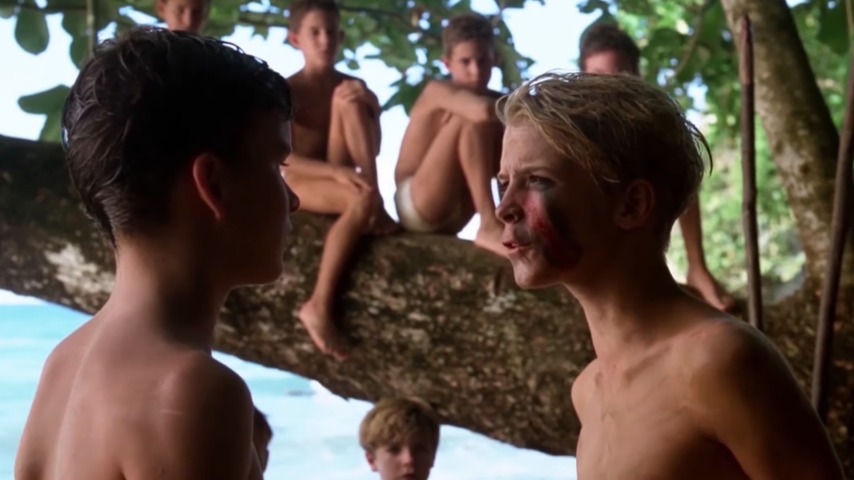Strangest fact: The boys’ lives were almost certainly saved by the destruction of their boat. The group mistakenly believed they were heading to Samoa, north of Tonga, but they were in fact heading south, and beyond ‘Ata was thousands of miles of open ocean between the Tonga island chain and Antarctica. The anchor rope, sail, and rudder were quick casualties of the storm winds, and the boys were adrift for eight days in a leaking boat until they sighted ‘Ata. They swam for 36 hours until they got to land, using salvaged planks from what was left of their boat.
Thing we were happiest to learn: The boys’ experience was more Cast Away than Lord Of The Flies. They happily worked together, hunting seabirds for meat and eggs, and exploring the island. Eventually, they made a two-day climb to the top of the volcanic mountain at the center of the island, and discovered the abandoned village of Kolomaile (although Wikipedia links to a different Kolomaile, on the nearby island of ‘Eua). In and around the village, they found wild taro and bananas, and feral chickens roaming. They captured rainwater in hollowed-out tree trunks, and gave each other jobs gardening, cooking, and standing guard (against whom or what isn’t clear). One boy named Stephen used two sticks to start a fire, which he kept burning for more than a year. (He would go on to be an engineer.)
Thing we were unhappiest to learn: The castaways came home to a lawsuit. On September 11, 1966, an Australian fishing boat sailed near ‘Ata and captain Peter Warner spotted a group of unkempt, naked teenage boys through binoculars. Stephen swam out to the boat and explained the situation. Warner radioed shore, and was told the boys had been presumed dead and, “if it’s them, it’s a miracle!”
There was much celebration when the boys returned to shore. Tonga granted Warner fishing rights to trap the Pacific spiny lobster, native to their waters, and he offered to hire the castaways as his crew. He threw a party in their honor, but none of the boys showed up. They had been arrested for the theft of the boat over a year earlier. Warner arranged for a Sydney TV station to buy the rights to the castaways’ story; they used some of the money to compensate the boat’s owner, who dropped the charges. The TV station’s 10-minute documentary is available on YouTube, and features the actual castaways re-enacting their experience on the island.
Best link to elsewhere on Wikipedia: ‘Ata itself has a surprising amount of history for a 450-acre atoll, to the point where the Tongan castaways are a footnote on the island’s own Wiki page. According to myth, ‘Ata and ‘Eua were the first islands created by the Maui brothers, Polynesian gods credited with creating the volcanic island chain that stretches from New Zealand to Samoa. The island was independent for most of its existence, because of its distance from Tonga, but once outsiders discovered the place (Abel Tasman sailed past shortly after becoming the first European to reach New Zealand; James Cook landed at ‘Ata on his second voyage), things came to an abrupt end. In 1863, Peru was looking for workers to collect guano on the Chincha Islands; when they couldn’t find willing volunteers, they simply kidnapped half of ‘Ata’s population (roughly 144 people) into slavery. The rest fled to the nearby island of ‘Eua for safety (founding the other town named Kolomaile), and were able to warn their neighbors well enough that the island of ‘Uiha was able to fight off a slave ship and not lose any captives. ‘Ata remained uninhabited until our castaways landed there a century later.
Further down the Wormhole: After their rescue, Mano spoke to U.K. newspaper The Guardian, saying of the rescuers, “they were so scared [at first], because we were all naked, long hair… luckily we could speak to him in English.” The Guardian is well-known for its journalistic integrity, and in the 2000s opposed Britain’s involvement in the Iraq War, despite having supported its chief proponent, Tony Blair. Blair’s Wikipedia page is loaded down with photographs of the former Prime Minister shaking hands with all manner of world leaders, but it also contains a photo of Blair and Cherie Booth, his wife, in a recreation of the Amber Room. We’ll visit the ornate, palatial room that was stolen by the Nazis next month.

